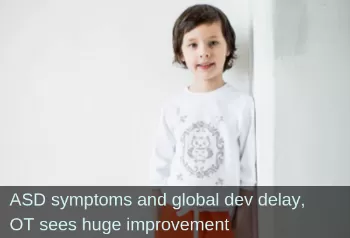Primitive Reflex Integration Case Studies
ASD Symptoms and Global Dev Delay; OT Sees Huge Improvement
After two sessions of primitive reflex integration, boy can tie shoes without prompts
This 8-year-old with autism characteristics, failure to thrive, and developmental delay made immense progress in regulation and motor skills—such as shoe tying—just a few weeks after starting rhythmic movements and primitive reflex integration from the Brain and Sensory Foundations course. He also experienced a reduction in bedwetting.
Submitted by T.A. MS, OTR/L Pediatric Occupational Therapist

| Before | After |
|---|---|
| Unable to tie shoes without sequencing prompts | Able to tie shoes completely independently |
| Almost nightly bed wetting | Experiences dry nights 2-3 times per week |
| Difficulty focusing | Improved attention span |
8 year old male client presents with ASD [Autism Spectrum Disorder], global developmental delays, and failure to thrive (recent endoscopy revealed severe esophageal swelling which had likely been the main contributor to life-long avoidance of eating). Relatively high cognitive functioning, however, emotionally operating around 3-4 y.o. level. Client presents with all reflexes from [the Brain and Sensory Foundations] course strongly retained.
I chose to begin with [innate] rhythmic movements: 1-because he loves rhythm/music and I thought buy-in would be high, and 2- to set the ground work for further reflex integration. I also started with core activation, TLR [Tonic Labyrinthine Reflex] integration, FPR [Fear Paralysis Reflex] integration, and Babinski [Reflex] integration in order to improve overall base of support and sense of grounded body position in space.
This client absolutely loved the [innate] rhythmic movements and was very calmed by them. When he would become up-regulated/too silly in session, we would take a quick “rhythm” break, where I would to the FPR tapping sequence and/or 2 rhythmic movements of his choice.
After just one session, he independently began trying to carry over [innate] rhythmic movements at home. Mom is usually very good about carrying over home programs, but he often resists implementation. It was awesome to hear that he was initiating the movements on his own, before I had even taught them to mom to practice at home!
We had been working on shoe tying all year and had gotten to minimal physical assistance for the whole task, with mod-max cues for attention and sequencing, and with frequent fumbling and trial/error. After the rhythmic movement and reflex work during the second session, he completed the WHOLE shoe tying sequence independently after 2 attempts—no motor planning cues, no attention cues, no fumbling.
I don’t want to jump to conclusions on the effects of general brain maturity, but after 6 weeks of RM and reflex work, the client lost his first 2 teeth (pretty late in life to only start losing teeth) and began having 2-3 consecutive “dry” nights each week (never had more than 1, only every once in a while).
I was worried these activities would take up time in our sessions and take away from other things we needed to work on, but it was actually a time saver. I was able to target goals more frequently once I implemented these strategies because his attention and regulation improved so much.
[Edited for length and clarity; emphasis added]
*Disclaimer: The activities in the Brain and Sensory Foundations curriculum make use of the natural processes of neuroplasticity and development that are innately wired in the design of human beings to promote maturity and function. These activities appear to calm, organize, and mature the neuro-sensory-motor systems just as we see in the healthy development of human infants. Individual results may vary, and we do not claim to offer a diagnosis or cure for any specific condition or disorder. The Brain and Sensory Foundations activities appear to improve overall functioning resulting in measurable improvements for a range of conditions as demonstrated in over 1800 case studies from participants.

